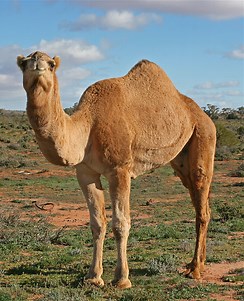The family
of Camelidae contains six species of artiodactyls. The most familiar are the two species of
humped camel; the other four species are South American Llamas and their
relatives known as cameloids.
The biggest
camelids and the tallest artiodactyls of the Old World’s camels are the Dromedary
and Bactrian camel.
The
dromedary are the Arabian camels, has one hump on its back and has a height of
2.4m at the shoulder. It is long legged, long-necked has beige or fawn colour
and live in North Africa, the Middle East and south-west Asia.
They have
been domesticated before 1000 BC. They still are used as transport; for their
milk; meat and wool.
The Tuareg,
Sahara normads, used to drove huge caravans of camels across the desert carrying
ivory, cold, salt and slaves.
Today’s
Tuareg rely on their camels when moving camps and transporting water and depend
on camel milk for food.
Today are no
truly wild dromedaries – most are kept in a semi-wild state or live as feral
flocks. The big herds in Australia have been imported and run free in the
outback. India has about 1,2 million but well over half of the world’s 12.5
million dromedaries live in Africa.
Most Africa
dromedaries are left to roam and forage on their own but depend on humans for
water.
 |
| CAMEL BACTRIAN |
The Bactrian
camel is smaller, shaggier and stockier and has two humps. It is a native of
Central Asia and has been domesticated for centuries. Only a few wild animals
can be found in the deserts of Mongolia and western China.
The
domesticated Bactrian is a dark brown to beige, stocky, robust beast with two
large humps and beefy legs to carry loads. The wild bactrian camel is long
legged and svelte animals with small, pert lumps.
Both species
have horny callosities on their chest and leg joints to protect them from the
scorching ground when they sit down.
They are
only about 1,000 bactrian left in th wild and live in protected areas as the
Gobi Desert in Mongolia, Desert of Lop and Takla Makan Desert in China.
In the
mating season a bull claims severalf females and fights off any rival.
Afterwards he leaves them.
Camels are
specially equipped for the desert. The two toes on each foot are joined by a
web of skin with a tough pad beneath. When it steps on the sand it splays out
preventing the animal from sinking in.
Their blood
cells are unique. It carries elliptical red cells instead of by-concave disc-shaped
ones. It prevents the blood thickening at hot temperature.
Their hump
is not a water storage tank, as widely known, but a fatty reserve for times of
food shortage .In dry areas, camels can survive for weeks without a drink. If
dew-covered vegetation or succulents are available they do not need to drink at
all.
The camel
has various water-saving features. The think coat prevents water losses. It can
allow its body temperature rise as much as 8C in the heat of the day and cool
in the chill of the night. It only starts sweating at 40C and over.
The kidney
also function differently. They absorb most of the water taken in and its urine
is concentrated and contains very little water. Its dropping is dry.
In the
desert’s heat they will lose some water but the camel suffers after losing 40
per cent of their body weight in water.
When there
is water the camel drinks buckets of water in a very short time, 100 litres in
a few minutes. This gulping down fluid in such a short time would be dangerous
for any other animals.


No comments:
Post a Comment